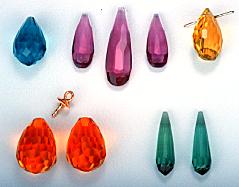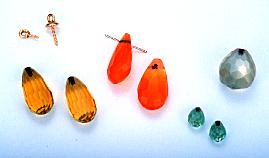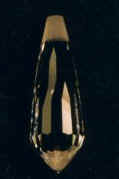English
Castellano
Català
Briolette Setting Techniques
Author: Steve Green
Content by courtesy of : Briolettes - www.briolettes.com
Setting briolettes has been a confusing issue. Unavailability of drilling services, poor fitting caps, improper surface preparation, and incorrect adhesives have all been obstacles in the past, leading to a reluctance amongst jewelers to use briolettes. Here at Rough And Ready Gems we have solutions for these problems. Our sound and logical suggestions are based on tried and proven methods. Please read on.
We recommend 3 methods of mounting briolettes:

blue apatite, set of 3 rubelites, cross-drilled lemon citrine / golden citrine pair vertically drilled with Stuller pin-cap, pair of tourmaline with air-abraded tips.
1) Drilling a vertical blind hole in the top of the briolette 2-4 mm deep, and adhering a pin-cap in the hole works well for all briolettes, and makes for a finished product lighter in look and feel than the conical cap method, below. This method is best for briolettes too small to cap and allows for one standard pin-cap for most briolettes.
2) Cross-drilling horizontally through the top of the briolette allows the gem to swing freely on a wire or pin, avoiding adhesives altogether. This method is not as strong as the other two methods but is preferred by people who think "adhesive" is a dirty word. Cross-drilling works well with any briolettes of sufficient size.
3) Bonding a conical cap to the briolette with epoxy adhesive avoids holes which weaken the gem. To achieve a strong bond between cap and briolette, it is critical to prepare the briolette's contact area by air-abrasion ("sand blasting") of 3-8 mm of the briolette tip. We pioneered this technique, which allows for the visual effect of more precious metal and gives very strong results due to the larger adhered surface area. External air-abrasion with conical caps works well for all but the smallest briolettes.
ULTRASONIC DRILLING:

Examples of ultrasonic drill holes stained with black ink for easy viewing. Lemon citrine 7.5x15, emerald 5x6, green moonstone 10x11 all top-drilled; orange opals 5x7x16, with pin through hole, are cross-drilled. Stuller pin-caps shown in upper left.
With this type of drill, small diameter, accurate holes can be drilled into very hard materials. Rough and Ready Gems now offers ultrasonic drilling on our briolettes. We have the most success with 0.020", 0.025" and 0.030" diameter holes, depending upon the application. Stuller manufactures a "pearl bail", item #29 in their Findings Catalog, which may be trimmed into a pin-cap for use on briolettes. Trimming the pearl bail's top cap and pin to size will give excellent results for setting briolettes when top drilled. When using a pin-cap with a drilled briolette, it is important that the pin diameter and length match the hole.
Rough and Ready Gems will ultrasonically drill our briolettes for $8.00 per blind vertical hole and $14.00 per cross-drilled (horizontal) hole. We guarantee to replace any briolettes damaged or broken during drilling.
We discourage externally notching or scratching briolettes with abrasive wheels or sand paper, as these methods create stressed areas prone to shear if impacted. If you have ever seen how glass is cut, the result is similar: score the glass or briolette and it tends to crack along the line.
REPEAT: We strongly discourage notching or abrasive scratching of the briolettes.
EXTERNAL AIR-ABRASION:
 |
| Citrine briolette showing air-abrasion prior to adhesion. |
External air-abrasion (sandblasting) allows all briolettes to be set with confidence. It is the strongest most durable method of setting briolettes when using a cap. External air-abrasion creates an excellent stress free surface finish optimizing the adhesive's strength and longevity. Air-abrasion increases the surface area of the portion of the briolette to be bonded. It also gives "peaks and valleys" into which the adhesive can gain a mechanical hold.
External Air-Abrasion Procedure:
To achieve maximum strength and longevity in the briolette setting we recommend that 3-8 mm of the briolette tip be air-abraded. The same should be done to the interior of the briolette cap. (Danville Engineering makes an inexpensive, under $100, micro-sandblaster. Their tel. is (800) 827-7940). External air abrasion removes very little structural material from the briolette, and thus does little to weaken it or instill any stressed areas. The air-abraded surface provides far superior adhesion than a smooth/polished surface.
First the briolette is masked, exposing only the tip to be air abraded. We have found that by embedding the briolette in modeling clay, leaving only the portion to be air-abraded exposed, good controllable results can be obtained. (We use PLASTILINA brand modeling clay available at art & hobby supply stores.)
Both silicon carbide, or aluminum oxide are good abrasive media. (aluminum oxide is less mess) 180 grit aluminum oxide is our choice for everything except sapphire which requires the harder silicon carbide.
Using 60-80 psi, go slowly and start from far enough back to gauge your progress. Only take off the polished surface for good adhesion. Rough and Ready Gems offers an air- abrasion service on their briolettes for $5.00 each.
After air-abrasion of the briolette and cap, clean both in warm soapy (Ivory Liquid dish soap) water, next rinse in warm water, then rinse again with denatured ethanol alcohol or acetone. Do not use rubbing alcohol since it may contain oils. Do not touch or contaminate the surfaces before adhesion. Acetone is our degreaser of choice, but beware of the fumes as they are toxic and highly flammable.
ADHESIVES:
We recommend epoxy adhesives due to their strength, ability to fill gaps (up to 0.040"), quick setting times, shock resistance, and transparency. Be sure to mix them thoroughly and in the proper proportions. Mix more epoxy than you will need. Small quantities are harder to measure correctly. Allow to stand shortly for bubbles to rise. Wet both the briolette hole and pin or cap. Work bubbles out of epoxy in drill hole for best appearance. Epoxies can be broken down with relatively low heat ( 300-400 F ), in case a piece needs disassembly (fumes are toxic). Uncured epoxies can be cleaned up with acetone or mineral spirits. See the Epoxy Tips section for more information.
3M Company makes a full line of epoxies. DP-100 CLEAR, and DP-100 PLUS CLEAR are both good for the job. They come in 50 ml tubes with a finger plunger for dispensing for under $15.00. For longer setting times (8-10 minutes) DP-110 TRANSLUCENT can be used.
Loctite Company also makes convenient and inexpensive epoxies under the Permatex brand name. Their product QM-50A comes in an easy to use 29.5 ml dispenser for the low price of $3.00. It is available at Checker and other auto parts stores.
Devcon Company also makes adhesives. We recommend Devcon 2-TON S-31 Epoxy, which is available at many retail stores, or from Rough and Ready.
3M Company's telephone is (800) 362-3550
Loctite Company's telephone is (800) 562-8483
Devcon's telephone is (800) 626-7226
We hope this information and our suggestions are helpful. We can supply your briolette needs with over 50 natural gem materials available in singles and matched pairs. To facilitate the setting of briolettes check out our 6 different angled caps.
Information | Mineral photos | VIDEOS | Articles | Fairs | Web directory | Classified ads | Minerals Books | Shop




